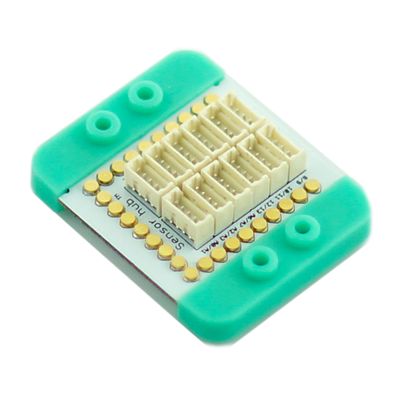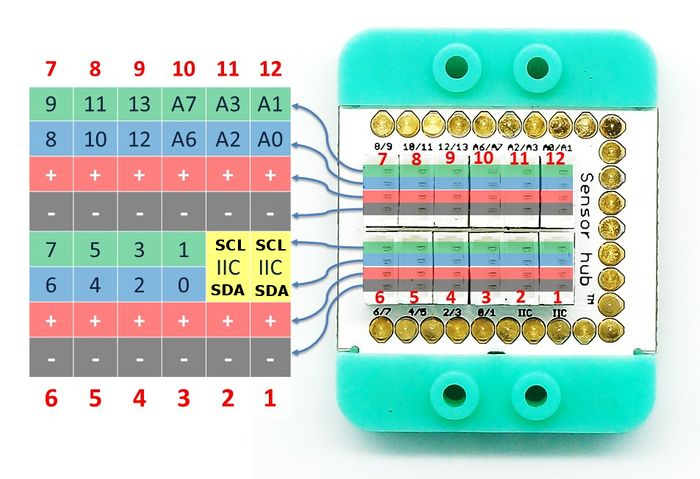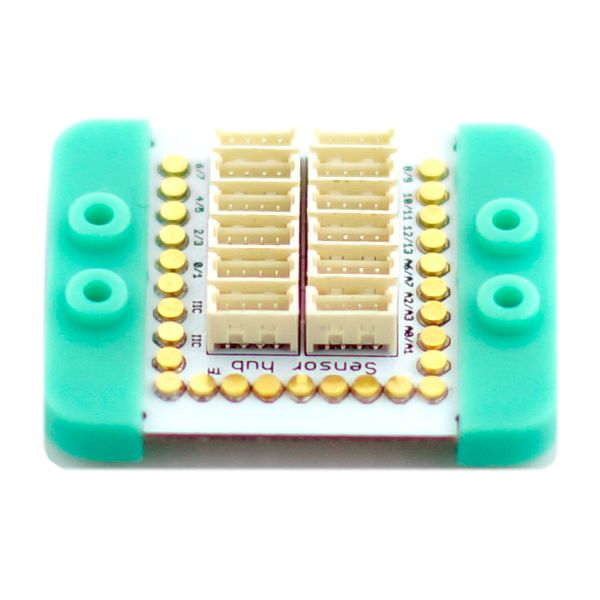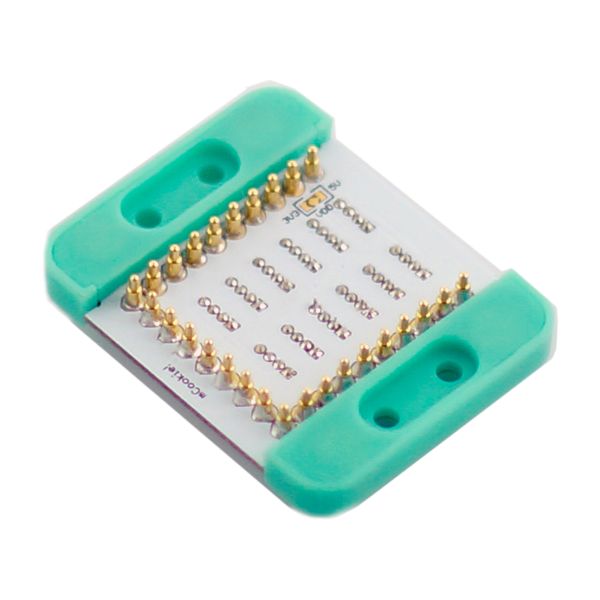Difference between revisions of "MCookie-Hub"
From Microduino Wiki
(→Pin Description) |
|||
| (16 intermediate revisions by one other user not shown) | |||
| Line 1: | Line 1: | ||
{{Language|mCookie-Hub}} | {{Language|mCookie-Hub}} | ||
| − | {| style="width: | + | {| style="width: 80%;" |
|- | |- | ||
| | | | ||
| Line 17: | Line 17: | ||
==Specification== | ==Specification== | ||
*All mCookie function pins are connected to the base board of the Hub, including digital, analog, serial port and IIC interface. | *All mCookie function pins are connected to the base board of the Hub, including digital, analog, serial port and IIC interface. | ||
| − | *Hub's interface pinout per header: '''GND, VCC, | + | *Hub's interface pinout per header: '''GND''', '''VCC''', '''GPIO-A''' and '''GPIO-B'''. |
*Two IIC interfaces. | *Two IIC interfaces. | ||
*Uses 4 pin, 1.25mm pitch JST headers / connectors. | *Uses 4 pin, 1.25mm pitch JST headers / connectors. | ||
===Pin Description=== | ===Pin Description=== | ||
| − | Most sensors / trinkets use the first signal (SIGNAL A) when connecting to the sensor hub. | + | Most sensors / trinkets use the first signal ('''SIGNAL-A''') when connecting to the sensor hub. |
| Line 33: | Line 33: | ||
! Sensor / Trinket's Connector | ! Sensor / Trinket's Connector | ||
|- | |- | ||
| − | | style="background: #e6e6e6;" | GND ( - ) | + | | style="background: #e6e6e6;" | '''GND''' ( - ) |
| − | | (PIN1) GND | + | | (PIN1) '''GND''' |
|- | |- | ||
| − | | style="background: #ffcccc;" | VCC ( + ) | + | | style="background: #ffcccc;" | '''VCC''' ( + ) |
| − | | (PIN2) VCC | + | | (PIN2) '''VCC''' |
|- | |- | ||
| − | | style="background: #d1dffa;" | GPIO-A | + | | style="background: #d1dffa;" | '''GPIO-A''' |
| − | | (PIN3) SIGNAL A -- INPUT / OUTPUT (usually) | + | | (PIN3) '''SIGNAL-A''' -- INPUT / OUTPUT (usually) |
|- | |- | ||
| − | | style="background: #b3ffec;" | GPIO-B | + | | style="background: #b3ffec;" | '''GPIO-B''' |
| − | | (PIN4) SIGNAL B -- Not connected (usually) | + | | (PIN4) '''SIGNAL-B''' -- Not connected (usually) |
|} | |} | ||
</div> | </div> | ||
| Line 51: | Line 51: | ||
<div style="clear:both;"> | <div style="clear:both;"> | ||
| − | Therefore, when referencing the sensor / trinket in code. Use the '''first''' number on the labeled header. | + | *Therefore, when referencing the sensor / trinket in code. Use the '''first''' number ('''GPIO-A''') on the labeled header. See examples below. |
| − | + | *Some modules use both signals A & B, but they are limited. | |
| − | In order to use the second signal. An IO | + | *Please refer to the specific sensor / trinket page for more detailed information on a specific one. |
| − | + | *In order to use the second signal. An IO split is used to split the signals out into two separate connectors. More can be read about the IO split: <big>'''[[Sensor-IO_Split|IO Split]]'''</big> | |
| − | + | *IIC (I2C) uses both signals, but these headers are strictly for IIC communication. | |
| − | + | <div style="float: left"> | |
| − | + | {| class="wikitable" | |
| + | |+ style="text-align: center;" | <big>Header & GPIO-A / GPIO-B <br/> Mapping</big> | ||
| + | |- | ||
| + | ! style="text-align: center;" | # | ||
| + | ! style="width: 60px;text-align: left;" | Label | ||
| + | ! style="width: 60px; background: #d1dffa;text-align: left;" | GPIO-A | ||
| + | ! style="width: 60px; background: #b3ffec;text-align: left;" | GPIO-B | ||
| + | |- | ||
| + | ! style="color: red;" | 1 | ||
| + | | IIC || rowspan="2" style="background: #ffffcc;" | SDA || rowspan="2" style="background: #ffffcc;"| SCL | ||
| + | |- | ||
| + | ! style="color: red;" | 2 | ||
| + | | IIC | ||
| + | |- | ||
| + | ! style="color: red;" | 3 | ||
| + | | 0/1 || 0 || 1 | ||
| + | |- | ||
| + | ! style="color: red;" | 4 | ||
| + | | 2/3 || 2 || 3 | ||
| + | |- | ||
| + | ! style="color: red;" | 5 | ||
| + | | 4/5 || 4 || 5 | ||
| + | |- | ||
| + | ! style="color: red;" | 6 | ||
| + | | 6/7 || 6 || 7 | ||
| + | |- | ||
| + | ! style="color: red;"| 7 | ||
| + | | 8/9 || 8 || 9 | ||
| + | |- | ||
| + | ! style="color: red;"| 8 | ||
| + | | 10/11 || 10 || 11 | ||
| + | |- | ||
| + | ! style="color: red;"| 9 | ||
| + | | 12/13 || 12 || 13 | ||
| + | |- | ||
| + | ! style="color: red;"| 10 | ||
| + | | A6/A7 || A6 || A7 | ||
| + | |- | ||
| + | ! style="color: red;"| 11 | ||
| + | | A2/A3 || A2 || A3 | ||
| + | |- | ||
| + | ! style="color: red;"| 12 | ||
| + | | A0/A1 || A0 || A1 | ||
| + | |} | ||
| + | </div> | ||
| + | <div style="float: left;"> | ||
| + | [[file:mCookie-sensorhub_rule.JPG|thumb|700px|center]] | ||
| + | </div> | ||
| + | <div style="clear:both;"> | ||
====Example==== | ====Example==== | ||
| − | *With a '''[[Sensor-Light-A1|Light Sensor]]''' that is plugged into the '''A2/A3''' header. Use '''A2''' to access the light sensor. | + | *With a '''[[Sensor-Light-A1|Light Sensor]]''' that is plugged into the '''A2/A3''' header. Use '''A2''' to access the light sensor. ('''On the A2/A3 header: GPIO-A=A2; GPIO-B=A3''') |
| − | *With an '''[[Sensor-LED|Single Color LED]]''' that is plugged into the '''6/7''' header. Use '''6''' to control the LED. | + | *With an '''[[Sensor-LED|Single Color LED]]''' that is plugged into the '''6/7''' header. Use '''6''' to control the LED. ('''On the 6/7 header: GPIO-A=6; GPIO-B=7''') |
| − | Each sensor / trinket page has more specific details to which pins are used, but the general rule is use the first signal. | + | Each sensor / trinket page has more specific details to which pins are used, but the general rule is use the first signal ('''SIGNAL-A'''). |
Each sensor / trinket may require usage of a specific type of pin, such as an analog pin. This information can be found on the wiki page for that specific sensor / trinket. | Each sensor / trinket may require usage of a specific type of pin, such as an analog pin. This information can be found on the wiki page for that specific sensor / trinket. | ||
| − | |||
| − | |||
| − | |||
==Document== | ==Document== | ||
Latest revision as of 03:32, 4 August 2017
| Language: | English • 中文 |
|---|
|
mCookie-Hub is designed for ease of the connection between Microduino Sensor Series and the core modules on the UPIN27 base board as well as further extended experiment.
ContentsFeatures
Specification
Pin DescriptionMost sensors / trinkets use the first signal (SIGNAL-A) when connecting to the sensor hub.
Example
Each sensor / trinket page has more specific details to which pins are used, but the general rule is use the first signal (SIGNAL-A). Each sensor / trinket may require usage of a specific type of pin, such as an analog pin. This information can be found on the wiki page for that specific sensor / trinket. DocumentDevelopment
ProjectPurchaseHistoryPicturesVideo |




